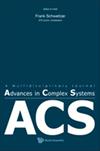随机网络中边缘相关性的影响
IF 1
4区 数学
Q4 MATHEMATICS, INTERDISCIPLINARY APPLICATIONS
引用次数: 0
摘要
随机图是现实生活中常用的随机网络模型。经典的Erdös-Rényi随机图模型得到了很好的研究,并具有许多非平凡性质。特别是,在确定性情况下难以计算的大量重要图参数在随机图中往往变得容易得多。然而,Erdös-Rényi随机图的一个基本限制是要求边是概率独立的。这是一个严重的限制,在大多数现实生活中的网络中并不成立。我们考虑更一般的随机图,其中的边可能是相关的。具体分析了两种模型。第一个被称为p鲁棒随机图。它的定义是要求每条边的存在概率至少为p,无论我们如何确定其他边的存在与否。它比假设独立边以p的概率存在要普遍得多,通过几个特殊的例子来证明。第二个模型考虑的是边是正相关的情况,这意味着每条边的边概率至少为p,无论我们如何确定其他边的存在(但不考虑缺席)。我们证明了关于这两个模型的一些有趣的,非平凡的性质。本文章由计算机程序翻译,如有差异,请以英文原文为准。
The Impact of Edge Correlations in Random Networks
Random graphs are frequently used models of real-life random networks. The classical Erdös–Rényi random graph model is very well explored and has numerous nontrivial properties. In particular, a good number of important graph parameters that are hard to compute in the deterministic case often become much easier in random graphs. However, a fundamental restriction in the Erdös–Rényi random graph is that the edges are required to be probabilistically independent. This is a severe restriction, which does not hold in most real-life networks. We consider more general random graphs in which the edges may be dependent. Specifically, two models are analyzed. The first one is called a p-robust random graph. It is defined by the requirement that each edge exist with probability at least p, no matter how we condition on the presence/absence of other edges. It is significantly more general than assuming independent edges existing with probability p, as exemplified via several special cases. The second model considers the case when the edges are positively correlated, which means that the edge probability is at least p for each edge, no matter how we condition on the presence of other edges (but absence is not considered). We prove some interesting, nontrivial properties about both models.
求助全文
通过发布文献求助,成功后即可免费获取论文全文。
去求助
来源期刊

Advances in Complex Systems
综合性期刊-数学跨学科应用
CiteScore
1.40
自引率
0.00%
发文量
121
审稿时长
6-12 weeks
期刊介绍:
Advances in Complex Systems aims to provide a unique medium of communication for multidisciplinary approaches, either empirical or theoretical, to the study of complex systems. The latter are seen as systems comprised of multiple interacting components, or agents. Nonlinear feedback processes, stochastic influences, specific conditions for the supply of energy, matter, or information may lead to the emergence of new system qualities on the macroscopic scale that cannot be reduced to the dynamics of the agents. Quantitative approaches to the dynamics of complex systems have to consider a broad range of concepts, from analytical tools, statistical methods and computer simulations to distributed problem solving, learning and adaptation. This is an interdisciplinary enterprise.
 求助内容:
求助内容: 应助结果提醒方式:
应助结果提醒方式:


